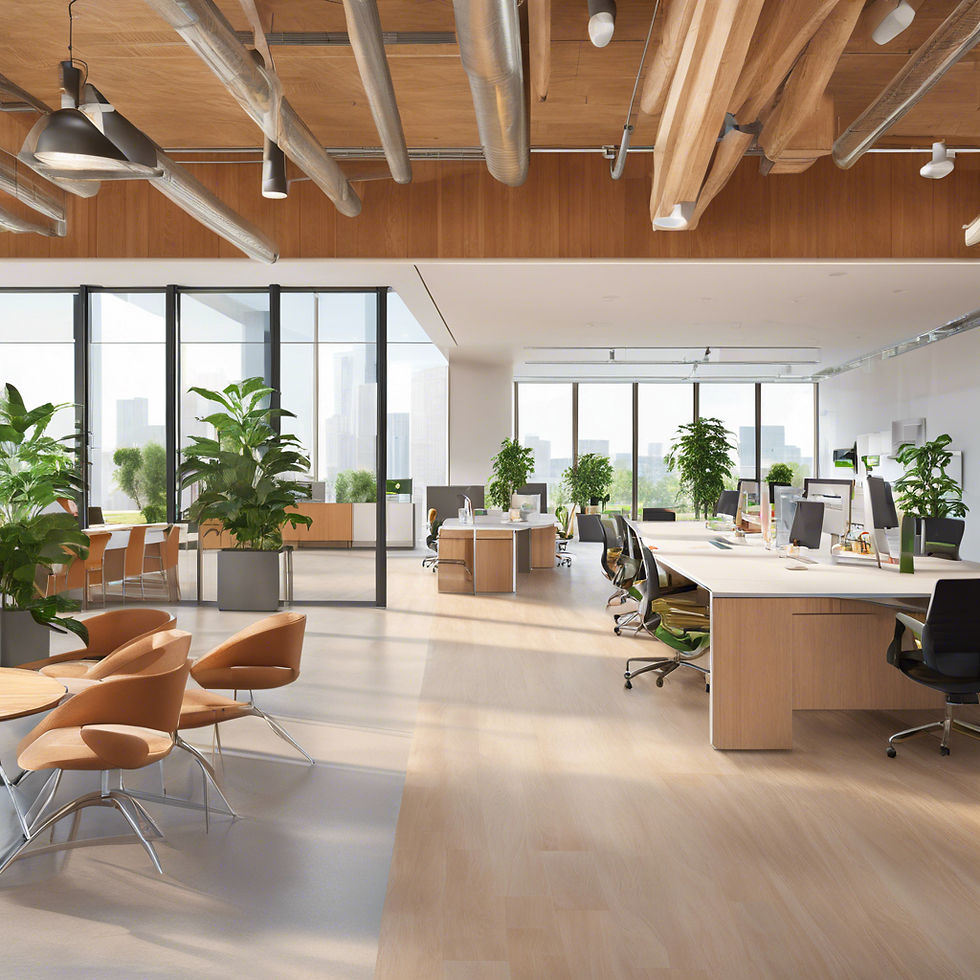Glossary
As businesses increasingly prioritize sustainability, choosing eco-friendly materials for office interiors has become essential. Not only do these eco friendly choices reduce environmental impact, but they also create healthier, more appealing office and workplaces. Here’s a comprehensive guide to selecting sustainable and eco friendly materials for your office interior design.
1. Sustainable Flooring Solutions
Bamboo Flooring
Bamboo is a fast-growing, renewable resource often used in interior designs. It offers a sleek, modern look and is more durable than many hardwoods. Bamboo floors are also relatively easy to maintain. Bamboo is a better eco friendly solution than wood as it has less environmental impact as compared to that of trees.

Recycled Carpet Tiles
Carpet tiles made from recycled materials, such as plastic bottles or old carpets, are an excellent choice for office interior design spaces. They are easy to install, replace, and maintain, making them a practical and sustainable option.

Cork Flooring
Cork flooring is a sustainable choice for an eco friendly interior design. Cork is harvested from the bark of cork oak trees, which naturally regenerate. It’s a highly sustainable material, providing excellent insulation and acoustic properties, ideal for busy office environments.

2. Sustainable Wall Treatments
Low-VOC Paints
Traditional paints release volatile organic compounds (VOCs) into the air, which can be harmful to health. Low-VOC or zero-VOC paints are much safer for indoor air quality and come in a variety of colors and finishes. These paints significantly enhance sustainability by reducing the emission of volatile organic compounds, which contribute to air pollution and health issues.

Reclaimed Wood Panels
Using reclaimed wood for wall treatments adds a rustic, unique charm to office interiors. It’s a great way to repurpose wood from old buildings, reducing the demand for new timber. Additionally, this eco-friendly practice helps lower carbon footprints and promotes sustainable building practices.

Living Walls
Incorporating living walls or vertical gardens can improve indoor air quality and provide a biophilic design element that enhances employee well-being and productivity. These walls can be created using various plant species, tailored to the office environment.

3. Eco Friendly Ceiling Solutions
Acoustic Ceiling Panels
Acoustic ceiling panels is a sustainable option for office interior design. Made from recycled materials such as PET plastic or old textiles, acoustic ceiling panels help reduce noise pollution in open office spaces. They are available in various shapes, sizes, and colors, contributing to both functionality and aesthetics.

Sustainable Ceiling Tiles
Ceiling tiles made from materials like recycled wood, metal, or natural fibers are eco-friendly options. They are lightweight, easy to install, and can significantly enhance the office’s environmental performance.

4. Sustainable Furniture Choices
Recycled or Upcycled Furniture
Look for furniture made from recycled or upcycled materials. This includes desks, chairs, and storage units crafted from reclaimed wood, metal, or plastic. These pieces not only reduce waste but also add a unique, characterful touch to the office.

Bamboo Furniture
Bamboo is not only great for flooring but also for furniture. It’s sturdy, lightweight, and grows quickly, making it an eco-friendly alternative to traditional wood furniture. Bamboo’s versatility allows for stylish and contemporary designs, making it a popular choice for sustainable interior decor.

Modular Furniture
Modular furniture systems are highly adaptable and can be reconfigured to meet changing needs, reducing the need for new furniture over time. Look for modular systems made from sustainable materials to maximize their eco-friendly potential.

5. Eco Friendly Doors and Windows
Energy-Efficient Windows
Install energy-efficient windows with low-E (low-emissivity) coatings to reduce energy consumption. These windows help maintain comfortable indoor temperatures, reducing the need for heating and cooling.

Reclaimed Wood Doors
Reclaimed wood doors add a vintage or rustic feel to office spaces while promoting sustainability. Each door is unique, bringing character and history into the workspace.

Natural Fiber Curtains and Blinds
Choose sustainable window treatments made from natural fibers such as organic cotton, linen, or hemp. These materials are eco friendly, renewable, biodegradable, and free from harmful chemicals.

6. Additional Sustainable Tips
Sustainable Lighting
Choose LED lighting, which consumes less energy and has a longer lifespan compared to traditional incandescent bulbs. Incorporate natural lighting as much as possible to reduce reliance on artificial lighting during the day.

Eco-Friendly Office Supplies
Stock the office with supplies made from recycled or sustainable materials. This includes paper, pens, notebooks, and cleaning products that are environmentally friendly.

Indoor Plants
Incorporate a variety of indoor plants to improve air quality and add a touch of nature. Plants like spider plants, peace lilies, and snake plants are low-maintenance and excellent at filtering indoor air.

Conclusion
Choosing sustainable and eco-friendly materials for your office interior not only benefits the environment but also creates a healthier and more pleasant workplace. By thoughtfully selecting materials, you can significantly reduce your office’s carbon footprint and promote a culture of sustainability within your organization.
By prioritizing eco-friendly design, businesses can contribute to a more sustainable future while also enhancing the well-being and productivity of their employees. At Pescora Design, we are committed to helping you create sophisticated, personalized, and sustainable office spaces tailored to your unique needs.
Comments